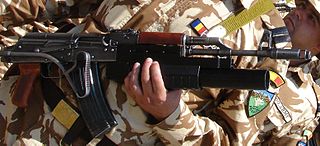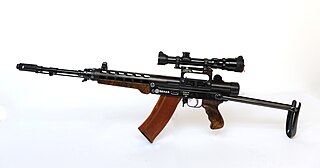 W
WThe A-91 is a bullpup assault rifle developed during the 1990s by KBP Instrument Design Bureau in Tula, Soviet Union as an offspring of the 9A-91 firearm family.
 W
WThe AEK-971 is a selective fire 5.45×39mm assault rifle that was developed at the Kovrov Mechanical Plant (KMZ) by chief designer Sergey Koksharov in the late 1970s and 1980s.
 W
WAG-043 (АГ-043) was a Soviet compact fully automatic assault rifle or carbine chambered for the 5.45×39mm round, developed in 1975. The weapon is a derivative of the earlier and similar AO-31 which also is Simonov's adaption of the AK-47.
 W
WIn the early 1970s the Soviet weapons-designer Mikhail Kalashnikov developed the AK-74 as an assault rifle to replace the earlier AKM. It uses a smaller 5.45×39mm cartridge, replacing the 7.62×39mm chambering of earlier Kalashnikov-pattern weapons.
 W
WThe AK-105 is a shortened carbine version of the AK-74M rifle, which in turn was derived from the original AK-47 design and its successor, the AK-74. The AK-102, AK-104, and AK-105 are very similar in design, the only difference being the caliber and corresponding magazine type. The AK-105 is chambered to fire 5.45×39mm ammunition.
 W
WThe 5.45 mm subkarabinek wz. 1989 Onyks is a lightweight Polish carbine variant of the 5.45 mm wz. 1988 Tantal assault rifle, also based on the AKS-74U Work on the weapon began in 1989 at the Ośrodek Badawczo-Rozwojowy state research institute in the city of Radom. The weapon’s technical specifications were confirmed that same year. It was not until 1990 that production approval was given for the first prototypes, evaluated the following year in a series of military qualification tests resulting in an order for an initial pre-production batch in 1993, to be manufactured at the Łucznik Arms Factory in Radom.
 W
WThe K-3 is an Armenian bullpup assault rifle chambered for 5.45×39mm ammunition with a selective fire system, selecting between semi-automatic mode, burst mode, and full automatic fire mode. Little is known about the production and variants of these firearms, as its production is veiled in secrecy, but it is evident they are being used by the Armenian Special Forces, as was displayed in the 2006 military parade. A new variant of the K-3 was unveiled to the public nearly a decade after its initial debut.
 W
WThe Pușcă Automată model 1986 is the standard assault rifle used by the Romanian Military Forces and manufactured in Cugir, Romania by the ROMARM firm, located in Bucharest. The export name for this variant is the AIMS-74.
 W
WThe Robinson Armament Co. XCR is a multi-caliber, gas piston weapon system developed by Robinson Armament Co. for U.S. Special Operations Command (SOCOM) to satisfy the requirements of the SOF Combat Assault Rifle, or SCAR competition, but was disqualified on a technicality due to late delivery of blank firing adapters. Robinson Armament continued development and the XCR is now being offered to law enforcement, the military and general public. Deliveries of the rifle began in mid-2006. The XCR was displayed to U.S. Army officials during an invitation-only Industry Day on November 13, 2008. The goal of the Industry Day was to review current carbine technology prior to writing formal requirements for a future replacement for the M4 Carbine.
 W
WThe TKB-0146 is a bullpup assault rifle prototype designed by Igor Yakovlevich Stechkin at the TsKIB SOO. The gun participated in the Russian Army's Project Abakan assault rifle trials.
 W
WThe VAHAN is an assault rifle of Soviet/Armenian origin and was designed by Engineer and Firearms Designer Vahan S. Manasian. It can be fitted with a GP-30 grenade launcher, bayonet and scope. The weapon dates back to 1952 as the MBC-2 when Manasian was a soldier in the Soviet Army. As of 2009, The VAHAN rifle has not yet been tested by Armenian government.
 W
WThe Wieger StG-940 was an East German series of assault rifles loosely based upon the Kalashnikov AK-74. The StG-940 was chambered in 5.56×45mm NATO and the StG-942 in 5.45×39mm M74.